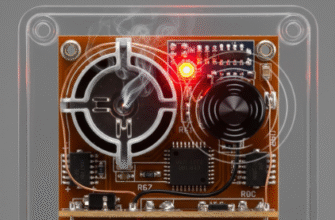That moment of anticipation just before a door opens – it’s a small drama played out countless times a day. But how the person on the other side signals their presence has undergone a fascinating transformation. Long before the familiar chime or electronic buzz, announcing your arrival was a far more physical, and sometimes louder, affair. Forget the polite ding-dong; think shouts, hefty knocks, or even the jingle of a personal bell.
Initially, proximity and lung power were key. You’d approach a dwelling and simply call out. If the door was sturdy or the inhabitants distant, a solid rap with knuckles or a convenient rock might do the trick. Door knockers, often ornate and heavy, emerged as a more ‘civilized’ evolution of this direct approach. These metal implements, shaped like rings, hands, or animal heads, offered a distinct sound and saved wear and tear on knuckles (and doors). They were status symbols as much as practical tools, their clang echoing through hallways, a clear signal that someone of consequence (or at least, someone with a knocker) stood outside.
The Rise of the Bell: Mechanical Marvels
The concept of using bells to announce presence wasn’t entirely new – think town criers or church bells. But bringing the bell to the individual doorstep took ingenuity. Early forms involved simple hand bells. A visitor might carry their own small bell, ringing it upon arrival. This seems quaint now, perhaps slightly comical, but it served its purpose, particularly where houses were set back from pathways or visibility was poor.
The real game-changer was the mechanical doorbell system, popularised in wealthier homes during the 18th and 19th centuries. These weren’t electric marvels yet, but intricate systems of wires, pulleys, and cranks. A visitor would typically pull a handle or turn a key located outside the door. This action would pull a wire running through the walls, often over a series of pulleys, culminating in a small hammer striking a bell mounted inside the house, usually in a servant’s area or central hallway.
Imagine the installation: threading wires through walls, ensuring the tension was just right, positioning the bell for optimal sound travel. It was a skilled job. These systems required maintenance; wires could stretch or snap, mechanisms could jam. The sound produced was usually a single, clear ‘ding’ or ‘clang,’ distinct from the eventual electric buzz or chime. Different pulls might even connect to different bells, signaling which entrance was being used – the main door, the tradesman’s entrance, etc. This mechanical era represented a significant step towards remote announcement, decoupling the visitor’s action from the immediate vicinity of the door itself.
Variations on a Mechanical Theme
Not all mechanical systems were identical. Some involved twists instead of pulls. Others employed more complex gearing. The core principle, however, remained the transfer of physical motion over a distance to create sound.
- Pull Handles: Often ornate brass or iron fixtures.
- Turn Keys: Required a twisting motion, sometimes less prone to breakage than pulls.
- Wire and Pulley Systems: The most common mechanism for transferring the action.
- Internal Bells: Typically brass or bronze, mounted prominently for audibility.
Electrifying Arrivals: The Dawn of the Doorbell
The leap to electric doorbells coincided with the broader harnessing of electricity in the 19th century. While several inventors experimented with electrical signaling devices, the invention of the practical electric doorbell is often credited to the Scottish inventor William Murdoch, who installed one in his own Birmingham house around 1817. However, widespread adoption had to wait for further developments in battery technology and electrical understanding.
Joseph Henry, an American scientist, is also a key figure. His work on electromagnets in the 1830s was crucial for developing devices like the telegraph and, indeed, the electric bell. The basic principle was simple yet revolutionary: pressing an external button completed an electrical circuit. This powered an electromagnet inside the house, which rapidly vibrated a small hammer against a bell or gong, creating a continuous buzzing or ringing sound as long as the button was pressed.
Verified History: While early experiments existed, the first electric doorbell patent in the US (Patent No. 1,737) was granted to Thomas N. Vail on June 20, 1871, although the underlying principles relied heavily on earlier work by figures like Joseph Henry. These early electric bells were powered by wet cell batteries, which required regular maintenance. The sound was often a harsh buzz, a stark contrast to the single chime of mechanical systems.
This shift was profound. Electric doorbells were generally more reliable than their mechanical counterparts (though early batteries could be problematic). They allowed for more flexibility in placement, as wires were easier to route than complex pulley systems. The sound, often a persistent buzz, was harder to ignore than a single mechanical ding. It marked a transition towards instant, inescapable notification. No longer did a visitor need to physically pull or turn; a simple press was sufficient.
Chimes, Tunes, and Wireless Wonders
The harsh buzz of the early electric bell eventually gave way to more pleasant sounds. Manufacturers developed electromechanical chimes that used solenoids (a type of electromagnet) to strike tuned metal bars or tubes, producing the familiar ‘ding-dong’ sequence. This became the standard sound for decades, offering a more melodic and less jarring announcement than the continuous buzz.
The evolution continued:
- Musical Doorbells: Novelty doorbells emerged capable of playing short tunes, moving beyond the simple two-note chime.
- Wireless Doorbells: The late 20th century brought radio technology to the doorstep. Wireless doorbells eliminated the need for complex wiring. A battery-powered button transmitted a radio signal to a receiver unit plugged into an outlet inside the house. This made installation incredibly simple, perfect for renters or retrofitting older homes.
- Intercom Systems: Combining the bell with a speaker and microphone allowed residents to speak with visitors before opening the door, adding a layer of security.
The Smart Doorbell Era: See, Hear, Speak
Today, we are firmly in the era of the smart doorbell. These devices are a far cry from William Murdoch’s early invention or even the simple wireless chimes of recent decades. Integrating cameras, microphones, speakers, and Wi-Fi connectivity, smart doorbells have fundamentally changed the interaction at our front doors.
Now, when someone presses the button (or sometimes, just approaches the door, thanks to motion sensors), a notification is sent directly to a smartphone or other connected device. Residents can see live video of the visitor, speak to them via two-way audio, and even receive alerts when they are away from home. This technology offers unprecedented convenience and security. You can instruct a delivery driver where to leave a package, screen visitors remotely, or capture footage of activity around your property.
From a shout across the yard to a live video feed on a phone screen continents away, the way we announce and acknowledge arrivals has mirrored technological progress. The simple act of letting someone know you’re outside has transformed from a physical effort to a sophisticated electronic exchange. While the technology is vastly different, the fundamental purpose remains the same: bridging the gap between outside and inside, managing that small moment of transition when a visitor arrives at the door. The humble doorbell, in all its forms, tells a story of innovation, changing social norms, and our enduring need to connect.
“`






